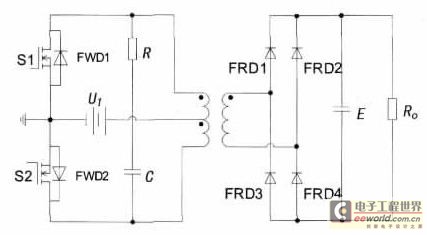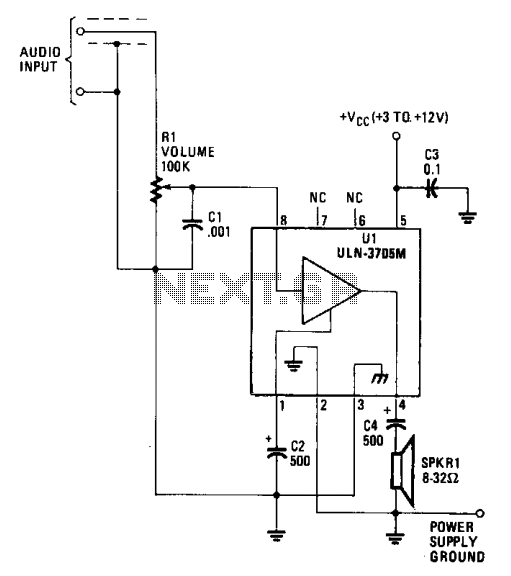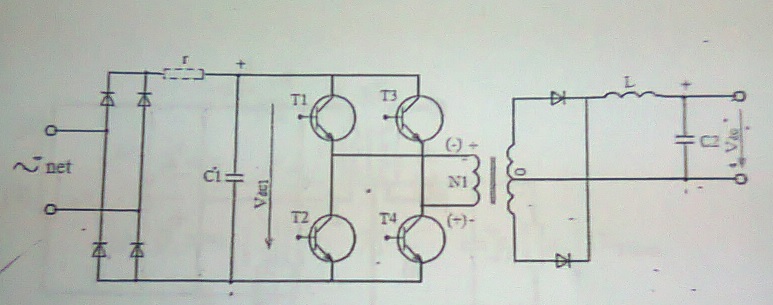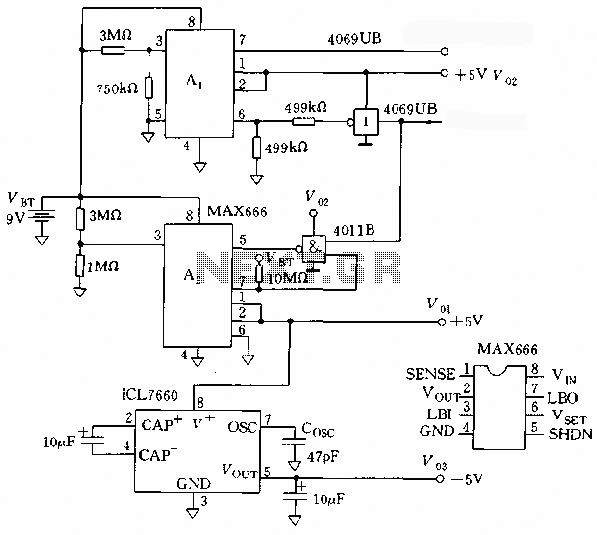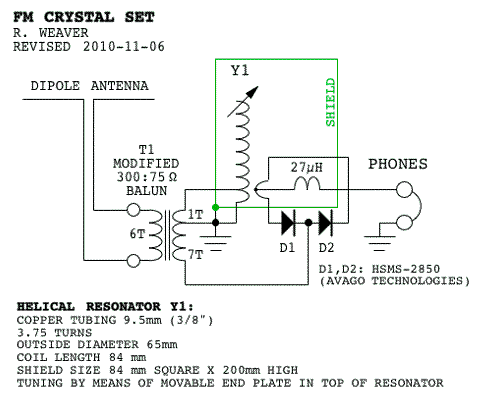
power supply am farm radio
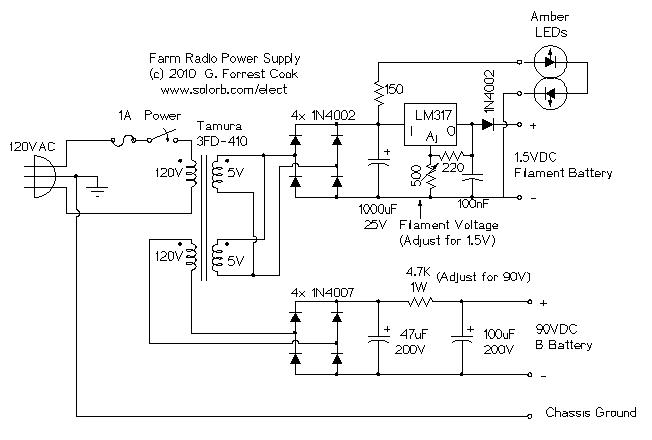
The ability accumulation is a Tamura 3FD-410 5V bifold primary/dual accessory transformer, available from DigiKey.com at reasonable prices. The transformer's primary windings can be configured in series for 240VAC operation or in parallel for 120VAC operation. This configuration utilizes one of the primary windings as a 120VAC secondary. To ensure proper functionality, the transformer must be slightly over-rated, which it is in this case. The two 5V accessory windings are connected in parallel and sent to a bridge rectifier and smoothing capacitor to produce approximately 7VDC. This DC voltage is current-limited by a 150-ohm resistor and is used to drive two amber LEDs. The LEDs can be affixed inside the radio above the punch to provide punch lighting and power-on indication. The 7VDC is also directed to an LM317 adjustable voltage regulator IC. The LM317 typically produces a minimum voltage of 1.7V, which is too high for this application. A series 1N4002 diode is used to drop approximately 0.5V, resulting in a minimum output voltage of 1.2V. The regulator is set to ensure that the filaments operate at 1.5VDC. The 90VDC B+ supply utilizes a bridge rectifier across the transformer's secondary winding to generate approximately 160VDC. The rectified DC is filtered through a pair of electrolytic capacitors and a series resistor, which reduces the B+ voltage to the required 90V.
The Tamura 3FD-410 transformer features dual primary windings, allowing for versatile voltage configurations. When connected in series, the transformer can handle 240VAC, while the parallel configuration allows for 120VAC applications. This flexibility makes it suitable for various electronic projects, particularly where different voltage requirements exist.
The two 5V accessory windings provide a reliable power source for low-voltage applications. The use of a bridge rectifier ensures efficient conversion of AC to DC, while the smoothing capacitor stabilizes the output voltage, minimizing ripple for sensitive components. The current-limiting resistor is essential for preventing excessive current flow, protecting the LEDs from damage.
The integration of the LM317 voltage regulator is a critical aspect of this design, allowing for adjustable output voltage to meet specific requirements. By incorporating a 1N4002 diode, the circuit achieves the desired output voltage for filament operation, ensuring optimal performance of connected components.
The high-voltage section of the circuit, utilizing the 90VDC B+ supply, is designed for applications requiring higher voltages. The bridge rectifier and filtering capacitors play a vital role in providing stable and clean DC voltage, essential for reliable operation of high-voltage devices. The series resistor in this section is carefully selected to ensure that the voltage is reduced to the desired level without compromising the overall performance of the circuit. This meticulous design approach ensures that all components operate within their specified limits, enhancing the longevity and reliability of the entire system.The affection of the ability accumulation is a Tamura 3FD-410 5V bifold primary/dual accessory transformer. These are accessible from DigiKey. com for reasonable prices. Normally, the transformer`s primary windings would be affiliated in alternation for 240VAC operation or in alongside for 120VAC operation.
This ambit takes one of the primaries and repurposes it as a 120VAC secondary. For this to work, the agent should be somewhat over-rated, which it is in this case. The two 5V accessory windings are accumulated in alongside and beatific to a arch rectifier and clarify capacitor to aftermath about 7VDC. This DC voltage is current-limited by a 150 ohm resistor and acclimated to drive two amber LEDs. The LEDs can be hot-glued to the central of the radio aloft the punch to accommodate punch lighting and power-on indication.
The 7VDC is additionally beatific to an LM317 adjustable voltage regulator IC. The LM317 commonly produces a minimum voltage of 1. 7V, which is too aerial for this application. A alternation 1N4002 diode is acclimated to bead about. 5V to aftermath a minimum voltage of 1. 2V. The regulator is adapted so that the filaments accomplish at 1. 5VDC. The 90VDC B+ accumulation uses a arch rectifier beyond the transformer`s additional primary ambagious to aftermath about 160VDC. The rectified DC is filtered through a brace of electrolytic capacitors and a alternation resistor. The resistor drops the B+ voltage to the appropriate 90V. 🔗 External reference
The Tamura 3FD-410 transformer features dual primary windings, allowing for versatile voltage configurations. When connected in series, the transformer can handle 240VAC, while the parallel configuration allows for 120VAC applications. This flexibility makes it suitable for various electronic projects, particularly where different voltage requirements exist.
The two 5V accessory windings provide a reliable power source for low-voltage applications. The use of a bridge rectifier ensures efficient conversion of AC to DC, while the smoothing capacitor stabilizes the output voltage, minimizing ripple for sensitive components. The current-limiting resistor is essential for preventing excessive current flow, protecting the LEDs from damage.
The integration of the LM317 voltage regulator is a critical aspect of this design, allowing for adjustable output voltage to meet specific requirements. By incorporating a 1N4002 diode, the circuit achieves the desired output voltage for filament operation, ensuring optimal performance of connected components.
The high-voltage section of the circuit, utilizing the 90VDC B+ supply, is designed for applications requiring higher voltages. The bridge rectifier and filtering capacitors play a vital role in providing stable and clean DC voltage, essential for reliable operation of high-voltage devices. The series resistor in this section is carefully selected to ensure that the voltage is reduced to the desired level without compromising the overall performance of the circuit. This meticulous design approach ensures that all components operate within their specified limits, enhancing the longevity and reliability of the entire system.The affection of the ability accumulation is a Tamura 3FD-410 5V bifold primary/dual accessory transformer. These are accessible from DigiKey. com for reasonable prices. Normally, the transformer`s primary windings would be affiliated in alternation for 240VAC operation or in alongside for 120VAC operation.
This ambit takes one of the primaries and repurposes it as a 120VAC secondary. For this to work, the agent should be somewhat over-rated, which it is in this case. The two 5V accessory windings are accumulated in alongside and beatific to a arch rectifier and clarify capacitor to aftermath about 7VDC. This DC voltage is current-limited by a 150 ohm resistor and acclimated to drive two amber LEDs. The LEDs can be hot-glued to the central of the radio aloft the punch to accommodate punch lighting and power-on indication.
The 7VDC is additionally beatific to an LM317 adjustable voltage regulator IC. The LM317 commonly produces a minimum voltage of 1. 7V, which is too aerial for this application. A alternation 1N4002 diode is acclimated to bead about. 5V to aftermath a minimum voltage of 1. 2V. The regulator is adapted so that the filaments accomplish at 1. 5VDC. The 90VDC B+ accumulation uses a arch rectifier beyond the transformer`s additional primary ambagious to aftermath about 160VDC. The rectified DC is filtered through a brace of electrolytic capacitors and a alternation resistor. The resistor drops the B+ voltage to the appropriate 90V. 🔗 External reference
